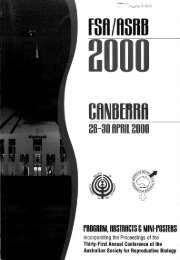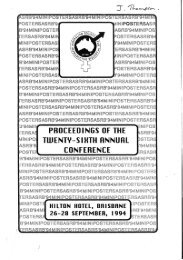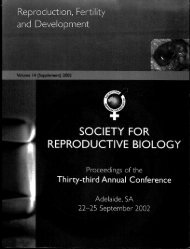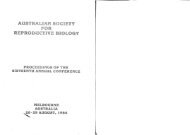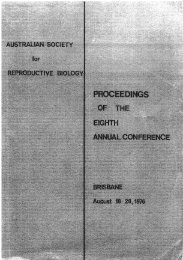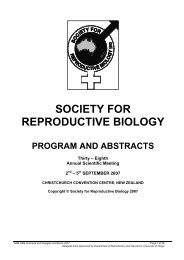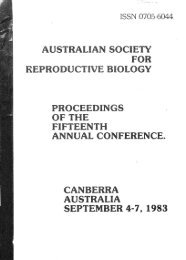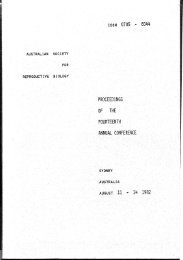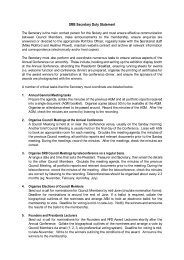N OCIETY' - the Society for Reproductive Biology
N OCIETY' - the Society for Reproductive Biology
N OCIETY' - the Society for Reproductive Biology
Create successful ePaper yourself
Turn your PDF publications into a flip-book with our unique Google optimized e-Paper software.
INTRODUCTIONFERTILITY OF FROZEN-THAWED POSSUM SPERMATOZOA AFTERLAPAROSCOPIC ARTIFICIAL INSEMINATIONMATERIALS AND METHODSRESULTS AND DISCUSSIONFemales inseminatedProportion pregnantTotal embryos (up to 4-cell)/eggsFC Molinia' and JV MyersCooperative Research Centre <strong>for</strong> <strong>the</strong> Conservation and Management of MarsupialsLandcare Research, PO Box 69, Lincoln 8152, New ZealandCryopreservation of spermatozoa as a gene-banking strategy, toge<strong>the</strong>r with relevant assisted-breedingtechniques, is likely to become an integral component of marsupial conservation biology (1). Recovery ofmotile spermatozoa has been achieved <strong>for</strong> <strong>the</strong> brushtail possum in diluents containing 17.5% glycerol (2,3).Recently, laparoscopic artificial insemination (AI) technology has been established <strong>for</strong> superovulated tammarwallabies and brushtail possums (4). In this study, <strong>the</strong> fertility of frozen-thawed possum spermatozoa wasexamined after laparoscopic AI.Female possums (n = 21) were superovulated with a single injection of 15 iu PMSG (Intervet, TheNe<strong>the</strong>rlands) followed 78 h later by 4 mg porcine LH (Vetrepharm, Australia). On each day of insemination,spermatozoa were flushed from <strong>the</strong> cauda epididymides of 2 males with EMEM media (EMEM with nonessential amino acids, 20 roM Hepes, 0.23 roM sodium pyruvate, 2.2 gIL sodium bicarbonate, 100 iu/mlpenicillin, 100 •g/ml streptomycin all from Sigma, USA, pH 7.4) (5). Samples were pooled and split into twoaliquots: one aliquot was stored at 4·C <strong>for</strong> <strong>the</strong> fresh sperm inseminations, <strong>the</strong> o<strong>the</strong>r was diluted 1: 1 withcryoprotectant media (35% glycerol in EMEM media), <strong>the</strong>n frozen in pellet-<strong>for</strong>m on dry ice and stored inliquid nitrogen (3), prior to thawing on <strong>the</strong> same day. Uterine insemination with fresh (n = 9) or frozenthawed(n = 9) spermatozoa (5 x 10 6 motile sperm/uterus in a 0.2 ml dose) was per<strong>for</strong>med with <strong>the</strong> aid of alaparoscope at 26-29 h post LH treatment. As a control, an additional 3 females were inseminated withEMEM media alone. Ovaries were examined and eggs recovered by flushing oviducts and uteri withheparinised (12.5 iu/ml) PBS, 2 days after AI. Eggs retrieved were stained with Hoechst 33342 (Sigma, USA)and assessed <strong>for</strong> fertility by fluorescence microscopy. Proportions of embryos recovered were compared by.2 analysis of contingency tables.Table 1: Fertility offresh and frozen-thawed spermatozoa after AI of PMSGILH superovulated possumsControl Fresh Frozen-thawed30/30/697/912/20This is <strong>the</strong> first time that fertile conceptions have been achieved with frozen-thawed sperm <strong>for</strong> any marsupial.Similar proportions of eggs were fertilized following AI with fresh or frozen-thawed spermatozoa and 1-2embryos per female were recovered as previously reported (4). Work is currently focussed on generatingviable young using AI with frozen-thawed spermatozoa, by allowing embryos to continue development invivo ei<strong>the</strong>r in <strong>the</strong> inseminated female or by using embryo transfer technology to surrogate recipients.REFERENCES1. Mate KE, Molinia FC, Rodger JC (1998) Anim Reprod Sci 53:65-76.2. Rodger JC, Cousins SJ, Mate KE (1991)Reprod Fertil Dev 3:119-125.3. Molinia FC, Rodger JC (1996) Reprod Fertil Dev 8:681-684.4. Molinia FC, Gibson RJ, Brown AM, Glazier AM, Rodger JC (1998) J Reprod Fertill13:9-17.5. Sistina Y, Lin M, Mate KE, Robinson ES, Rodger JC (1993) Reprod Fertil Dev 5:1-14.13495/911/28Birth of Koala pouch young following artificial inseminationSD Johnston a , MR McGowan a , P O'Callaghan\ R Coxc, B Houlden d , S Haig 2 and G Taddeo eaThe University ofQueensland, 4072;bLone Pine Koala Sanctuary (LPKS), Fig Tree Pocket, 4069; CBioquest Ltd., NorthRyde, 2113; dTaronga Zoo, PO Box 20, Mosman, 2088 and eCook Australia Pty I:..td, Eight Mile Plains, 4122.INTRODUCTIONRESULTS AND DISCUSSIONAssisted breeding technology offers exciting new alternatives AI using <strong>the</strong> "Cook" ca<strong>the</strong>ter procedure in Exp.l resulted into traditional methods of ex situ management and breeding of <strong>the</strong> birth of 2 pouch young from 5 attempts; <strong>the</strong>captive mammals. Although <strong>the</strong>se techniques are increasingly urogenitoscopic procedure resulted in 3 offspring from 4being used in <strong>the</strong> captive propagation of eu<strong>the</strong>rian wildlife, attempts. Results of progestogen estimations from Koalas onproduction of marsupials by means of artificial insemination day 14 and 28 post IC are shown in Table 1 and confIrm that(AI) has yet to be accomplished.a luteal phase was successfully induced in all 9 females.MATERIALS AND METHODSPaternity analysis revealed that all teaser males could beEleven mature female Koalas held at LPKS were artificially excluded as possible sires. The Koala pouch young producedinseminated between December 1997 and March 1998. in Exp.l represent <strong>the</strong> first marsupials conceived and bornFourteen mature males were used as "teasers" to induce following AI.ovulation by means of interrupted coitus (IC) (2), or as sperm In Exp. 2, AI resulted in <strong>the</strong> birth of one pouch young from 2donors. Semen was collected by means of an artificial vagina attempts. Although <strong>the</strong> injection of hCG in F48 appeared to(1). The mean (± s.e.m.) concentration, % <strong>for</strong>ward motility result in <strong>the</strong> subsequent induction of a luteal phase (Table 1),and rate of movement of Koala spermatozoa used in this no pouch young was produced. However, AI of F326 culminated in <strong>the</strong> birth of an offspring, providing strongstudy was 162.2 ± 33.9 x 10 I ml, 76.1 ± 2.6 and 3.9 ± 0.2, evidence that <strong>the</strong> administration of hCG in this animal, notrespectively. Undiluted semen was maintained at roomtemperature' <strong>for</strong> 15 to 30 min prior to insemination.only induced a luteal phase, but presumably resulted inovulation. This Koala is <strong>the</strong> only marsupial to be bornOvulation was induced in 9 oestrous females by <strong>the</strong> means offollowing both hormonal induction of presumed ovulationIC and two methods of insemination were used (Exp.1). Theand AI. Fur<strong>the</strong>r investigations are under way to determine <strong>the</strong>fIrst involved a custom designed insemination ca<strong>the</strong>terefficacy of this ovulation induction treatment, particularly in(Figure 1) used to deposit approximately 1 ml of undilutedregards to optimal dose rates and timing of administration ofsemen into <strong>the</strong> dorsal portion of <strong>the</strong> urogenital sinusimmediately caudal to <strong>the</strong> vaginal ostia (2). Five female hCG.Koalas were gently restrained and inseininated using thismethod. The second insemination method involvedvisualisation of <strong>the</strong> vaginal ostia by means of an otoscopefitted with a 70 mm x 10 mm speculum (Welch Allyn, Model# 20200, USA) and was facilitated by positioning <strong>the</strong> femalein ventral recumbency on a tilting table set at an incline ofapproximately 30°. This procedure was accomplished afteranaes<strong>the</strong>tising <strong>the</strong> female (3). In total approximately 1 ml ofundiluted semen was ei<strong>the</strong>r deposited into <strong>the</strong> most cranialportion of <strong>the</strong> urogenital sinus immediately caudal to <strong>the</strong>vaginal ostia or directly into <strong>the</strong> vaginae using a 3.5 Fr."Tom-cat" ca<strong>the</strong>ter (Becton Dickinson Labware, U.S.A).Four Koalas were inseminated using this method.Figure 1 : Cook insemination ca<strong>the</strong>ter (Scale: O. 5 x)Table I : Progestogen concentration (ng/ml) in <strong>the</strong> peripheralplasma of Koalas on <strong>the</strong> day of insemination (dO), 14 and 28days fo llowing attempted induction ofovulation.Induction of ovulation in 2 oestrous Koalas was attempted by Koala Induction I dO d14 d28 Pouchintra-muscular administration of 250 LV. of hCG AI methodyoung(Chorulon®, Intervet, Castle-Hill, Australia) on <strong>the</strong> day ofF8 IC I Cook 0.5 6.4 13.3 NOinsemination (Exp.2). One female (F48) was inseminatedF20 IC / Cook 1.0 4.9 9.8 YESusing <strong>the</strong> "Cook" ca<strong>the</strong>ter, <strong>the</strong> o<strong>the</strong>r (F32) using <strong>the</strong>F42 IC I Cook 0.2 3.1 12.0 NOurogenitoscopic procedure described above. All femaleF43 IC I Cook 0.2 4.9 7.1 NOKoalas were kept isolated from males following AI.F44 IC / Cook 0.3 9.4 26.0 YESSuccessful induction of a luteal phase in non-parturientF36 IC I Tomcat 0.9 5.4 11.2 NOKoalas was confirmed by demonstrating an elevatedF2 IC I Tomcat 0.1 3.4 20.8 YESprogestogen concentration on day 14 and 28 post IC orF28 Ie I Tomcat 0.1 8.7 11.9 YESfollowing injection of hCG. A progestogen concentrationF45 IC I Tomcat 0.5 4.8 10.0 YESabove that of <strong>the</strong> upper 99.95% confidence limit of basalF48 hCG I Cook 0.5 5.3 6.8 NOoestrous progestogen concentration noted on <strong>the</strong> day ofF32 hCGI Tomcat 0.2 7.5 15.5 YESinsemination (day 0) and derived from all 11 females wasconsidered confinnatory evidence that a luteal phase had beeninduced. This value was determined to be 0.7 ng I ml. In Exp.I, paternity analysis of resulting offspring (4) was alsoconducted in order to exclude teaser males as possible sires.REFERENCES1. Johnston SD (1999) Studies toward <strong>the</strong> development of anartificial insemination procedure in <strong>the</strong> Koala Phascolarctoscinereus. PhD Thesis, The University ofQueensland.2. Johnston SD et al., (1997) J Reprod Fert 109:319-323.3. McGowan MR et aI., (1995) Aust Vet J 72:472-473.4. Houlden Bet aI., (1996) Mol Ecol 5:269-281.135



